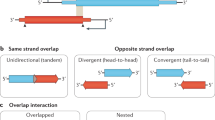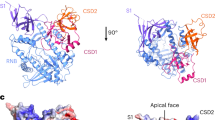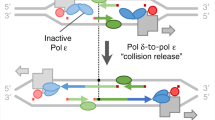Abstract
All the evidence so far points to a gene's protein-coding information being contained in only one of its two DNA strands, with this strand serving as a template for transcription of the precursor RNA that is eventually translated into protein1. Here we present structural evidence showing that the protein-coding information of the modifier of mdg4 (mod(mdg4)) gene of the fruitfly Drosophila is provided by both of its complementary DNA strands, and not by just one. This novel organization means that RNA precursors generated from two DNA templates need to be joined subsequently into a single messenger RNA, a surprising feature that raises new questions regarding genome complexity and evolution.
Similar content being viewed by others
Main
The mod(mdg4) proteins of Drosophila are required during the fly's development and probably help to establish or maintain chromatin structure2,3,4. The genomic sequence of this locus has been determined5 and Fig. 1a shows the arrangement of the mod(mdg4) region in the sequence (accession number AE003734), whose principal transcript is 2.2 kilobases (kb) long. Exons I to IV of the 2.2-kb RNA are transcribed from nucleotide positions 153,934 to 151,614; exons V and VI are transcribed from nucleotide positions 136,942 to 137,841 by using the complementary strand as template (Fig. 1a).
a, Top, genomic structure. Red and green boxes represent exons in different DNA strands. Arrows indicate the origin of transcription on each strand. A mutant, mod(mdg4)u1, is shown here that contains an insertion of the stalker retrotransposon at position 137,206 (according to sequence AE003734). Bottom, alternative mRNAs produced by the mod(mdg4) locus. Lines connecting exons indicate cis splicing; dashed line connects exons transcribed in the opposite orientation. b, Trans-spliced 2.2-kb mRNA is present in Drosophila total RNA. A 598-nucleotide antisense RNA probe containing the last 435 nucleotides from exon IV and the first 163 from exon V of the 2.2-kb mod(mdg4) mRNA was synthesized by in vitro transcription with T7 polymerase in the presence of [32P]CTP. The 598-nucleotide riboprobe used in the RNase protection assay is indicated. The 662-nucleotide fragment in lanes 3 and 4 corresponds to the riboprobe plus 64 extra nucleotides transcribed from the plasmid. Lane 1, 50 μg total Drosophila RNA; lanes 2 and 3, 50 μg yeast RNA; RNase was added only to lanes 1 and 2. Protected fragments of the predicted sizes are indicated on the left. On the basis of their size, additional bands are probably due to protection of other mod(mdg4) RNA species. Lane 4, size markers (nucleotides). c, RNA precursors and cis splicing or trans splicing at the mod(mdg4) locus (not to scale). Red and green boxes represent exons transcribed in opposite orientations. Pairing between both precursors facilitates trans splicing (circled) and the production of a functional mRNA. Further details are available from the authors.
To verify the arrangement of sequence AE003734, we used the polymerase chain reaction to amplify DNA from two unrelated wild-type fly strains and an array of nested primers located in coding and non-coding sequences. The amplified DNA fragments for all combinations of primers and for the two strains of fly were of the expected sizes (results not shown). We conclude that the 2.2-kb RNA appears to be encoded by two separate sequences of the gene transcribed in opposite orientations.
We confirmed that the 2.2-kb mRNA was present in fly cells by using a ribonuclease (RNase) protection assay and an RNA probe spanning exons IV and V (Fig. 1b), which revealed a fragment of 598 nucleotides, the size expected in the event of protection by a 2.2-kb mRNA. Other fragments predicted to result from protection by additional mod(mdg4) RNAs containing exons IV (435 nucleotides) and V (168 nucleotides) were also detected.
Different mechanisms could account for this 2.2-kb transcript. A switch to a different template by the transcribing enzyme RNA polymerase II, or a programmed genomic rearrangement to bring all the coding sequences to the same DNA strand, could explain why the precursor RNA should contain all six exons. To our knowledge, template switching by RNA polymerase II has never been described, and we have ruled out a genomic rearrangement by using Southern-blot analysis of genomic DNA (results not shown). However, recombination between precursor RNA molecules or trans splicing (the use of a splicing donor site from one RNA by the acceptor site from a second6) are two other mechanisms that would involve two independent RNA precursors. Of these possible mechanisms, only trans splicing has so far been reported in eukaryotes7.
The genomic organization of mod(mdg4) suggests that two RNA precursors are transcribed to yield the 2.2-kb mRNA. The RNA encoding the doom protein (Fig. 1a) is a candidate for one of these precursors8. It contains exons I to IV from the 2.2-kb mRNA and extends to nucleotide 131,723 ('class I' precursor in Fig. 1c). A second RNA precursor ('class II' precursor) containing exons V and VI probably originates at nucleotide 136,626 in a promoter region predicted by GENSCAN9 (Fig. 1a, c).
Figure 1c shows a simplified model of trans splicing and cis splicing (donor and acceptor sites on the same molecule) of RNA precursors at the mod(mdg4) locus — two nested transcription units in opposite orientation produce two partially complementary RNAs that are able to form double-stranded RNA. It has been shown by using engineered DNAs that sequence complementarity between two RNA molecules can facilitate trans splicing in transfected cells10.
Our results indicate that the evolutionary constraints imposed by a cis arrangement of the exons in a gene can be overcome by sequence complementarity between their encoded RNAs. Phylogenetic studies are needed to clarify the evolutionary process that shaped the genomic structure of mod(mdg4). Genome sequences will reveal whether analogous structures are present in other genes and organisms.
References
Burge, C. B., Tuschl, T. & Sharp, P. A. in The RNA World 2nd edn (eds Gesteland, R. F., Cech, T. R. & Atkins, J. F.) 525–560 (Cold Spring Harbor Laboratory Press, New York, 1999).
Gerasimova, T. I., Gdula, D. A., Gerasimov, D. V., Simonova, O. & Corces, V. G. Cell 82, 587–597 (1995).
Gerasimova, T. I. & Corces, V. G. Cell 92, 511–521 (1998).
Buchner, K. et al. Genetics 155, 141–157 (2000).
Adams, M. D. et al. Science 287, 2185–2195 (2000).
Agabian, N. Cell 61, 1157–1160 (1990).
Caudevilla, C. et al. Proc. Natl Acad. Sci. USA 95, 12185–12190 (1998).
Harvey, A. J., Bidwai, A. P. & Miller, L. K. Mol. Cell. Biol. 17, 2835–2843 (1997).
Burge, C. B. & Karlin, S. Curr. Opin. Struct. Biol. 8, 346–354 (1998).
Solnick, D. Cell 42, 157–164 (1985).
Author information
Authors and Affiliations
Corresponding author
Rights and permissions
About this article
Cite this article
Labrador, M., Mongelard, F., Plata-Rengifo, P. et al. Protein encoding by both DNA strands. Nature 409, 1000 (2001). https://doi.org/10.1038/35059000
Issue Date:
DOI: https://doi.org/10.1038/35059000
This article is cited by
-
A chimeric transcript containing Psy1 and a potential mRNA is associated with yellow flesh color in tomato accession PI 114490
Planta (2014)
-
Predicting mutually exclusive spliced exons based on exon length, splice site and reading frame conservation, and exon sequence homology
BMC Bioinformatics (2011)
-
Expansion of the eukaryotic proteome by alternative splicing
Nature (2010)
-
Trans-splicing in C. elegans generates the negative RNAi regulator ERI-6/7
Nature (2008)
-
Highly expressed genes are associated with inverse antisense transcription in mouse
Journal of Genetics (2007)
Comments
By submitting a comment you agree to abide by our Terms and Community Guidelines. If you find something abusive or that does not comply with our terms or guidelines please flag it as inappropriate.




